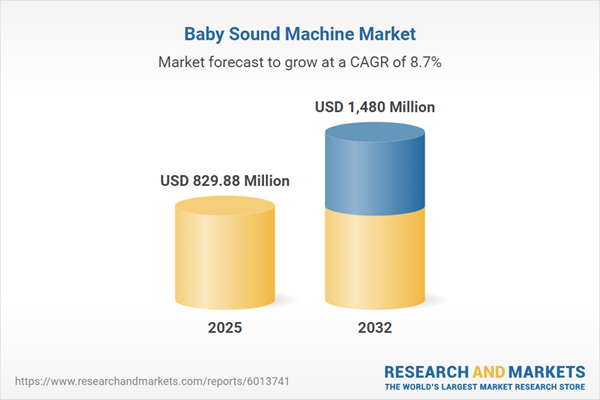Speak directly to the analyst to clarify any post sales queries you may have.
The baby sound machine market has become a significant focus area within the infant care industry as consumer expectations evolve and new audio technologies transform traditional product roles. Senior leaders assessing future opportunities need precise, actionable insights aligned with today’s complex market dynamics.
Market Snapshot: Baby Sound Machine Market Overview
The Baby Sound Machine Market grew from USD 761.99 million in 2024 to USD 829.88 million in 2025. It is expected to continue growing at a CAGR of 8.71%, reaching USD 1.48 billion by 2032. This expansion reflects increased demand from tech-forward parents, along with widespread interest in products that offer advanced connectivity, customization, and integration with digital ecosystems. Market growth is supported by both established industry players and new entrants leveraging global e-commerce, ensuring robust competition and innovation throughout the forecast period.
Scope & Segmentation: Strategic View of the Market
- Distribution Channels: Mass retail, specialty stores, branded e-commerce platforms, third-party online retailers.
- Product Types: App-controlled sound machines (Android, iOS, cross-platform), portable models with and without connectivity (Bluetooth, Wi-Fi, standalone), and stationary devices preloaded with lullabies, nature sounds, or white noise.
- End Users: Infants (0–6 months, 6–12 months) and toddlers (1–2 years, 2–3 years), each group requiring tailored soundscapes and features to match their developmental stages.
- Technologies: Analog (including motor-based and tape-based options) and digital (standard to high-fidelity), with manufacturers adopting various codecs and memory architectures for high-quality audio.
- Power Sources: AC adapters, USB options, and battery-powered devices (disposable or rechargeable), supporting portability and flexibility.
- Regions Covered: Americas (United States, Canada, Mexico, Brazil, Argentina, Chile, Colombia, Peru), Europe (UK, Germany, France, Russia, Italy, Spain, Netherlands, Sweden, Poland, Switzerland), Middle East and Africa (UAE, Saudi Arabia, Qatar, Turkey, Israel, South Africa, Nigeria, Egypt, Kenya), Asia-Pacific (China, India, Japan, Australia, South Korea, Indonesia, Thailand, Malaysia, Singapore, Taiwan).
- Leading Companies: Hatch Baby, Yogasleep, Adaptive Sound Technologies, HoMedics, Munchkin, Sound Oasis, Mattel, VTech Electronics North America, Skip Hop International, Crane USA.
Key Takeaways for Senior Decision-Makers
- The baby sound machine market is shaped by rising demand for products with digital features and smart home compatibility, aligning with broader trends in connected consumer electronics.
- Partnerships between audio tech providers and baby monitor brands are creating integrated solutions that address parental needs for both convenience and safety.
- The competitive landscape benefits from agile development by disruptors, who use direct-to-consumer channels and quick product iteration based on user feedback.
- Sustainability initiatives, including eco-friendly materials, recyclable packaging, and energy-efficient designs, are influencing product development and market preference, reflecting growing expectations for corporate responsibility.
- Regional growth varies: North America emphasizes premium features and seamless integration, while Asia-Pacific leads in digital innovation and value-driven offerings; regulatory compliance and luxury demand define opportunities in Europe, Middle East, and Africa.
Tariff Impact: Addressing Production and Pricing Adjustments
Forthcoming United States tariffs on electronic components are creating pressure on input costs and prompting firms to adapt their procurement and supply chain strategies. Organizations are increasingly exploring nearshoring and diversification of supplier relationships, especially in Mexico, Central America, and parts of Southeast Asia. Proactive engagement in government advocacy and scenario analysis supports resilience, enabling brands to minimize pricing volatility and safeguard long-term competitiveness.
Methodology & Data Sources
This report uses a rigorous methodology, combining primary interviews with industry executives, caregiver surveys, and consultations with regulatory bodies. Secondary research incorporates trade publications, technical whitepapers, and regulatory filings. Data reliability is enhanced through triangulation, cross-referencing shipment data and financial disclosures to validate qualitative and quantitative findings.
Why This Report Matters
- Delivers executive-ready insights to inform product strategy, supply chain planning, and market entry decisions in a rapidly evolving sector.
- Enables leaders to benchmark organizational readiness against innovation trends, sustainability standards, and changing global trade conditions.
Conclusion
Senior executives can use this report as a strategic guide to navigate technological, regulatory, and consumer shifts in the baby sound machine market, supporting data-backed growth and resilience initiatives.
Additional Product Information:
- Purchase of this report includes 1 year online access with quarterly updates.
- This report can be updated on request. Please contact our Customer Experience team using the Ask a Question widget on our website.
Table of Contents
3. Executive Summary
4. Market Overview
7. Cumulative Impact of Artificial Intelligence 2025
Companies Mentioned
The companies profiled in this Baby Sound Machine market report include:- Hatch Baby, Inc.
- Yogasleep, Inc.
- Adaptive Sound Technologies, Inc.
- HoMedics, Inc.
- Munchkin, Inc.
- Sound Oasis, LLC
- Mattel, Inc.
- VTech Electronics North America, LLC
- Skip Hop International, Inc.
- Crane USA, Inc.
Table Information
| Report Attribute | Details |
|---|---|
| No. of Pages | 180 |
| Published | October 2025 |
| Forecast Period | 2025 - 2032 |
| Estimated Market Value ( USD | $ 829.88 Million |
| Forecasted Market Value ( USD | $ 1480 Million |
| Compound Annual Growth Rate | 8.7% |
| Regions Covered | Global |
| No. of Companies Mentioned | 11 |









